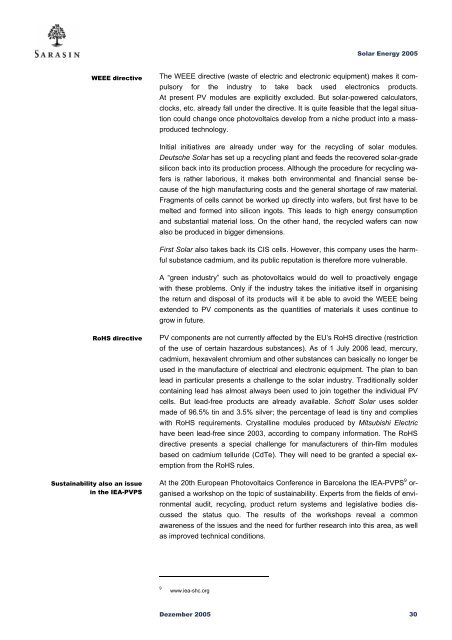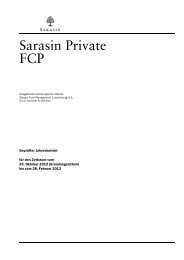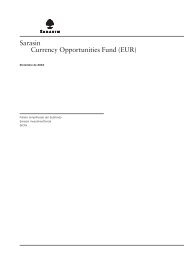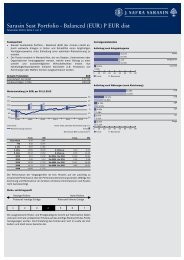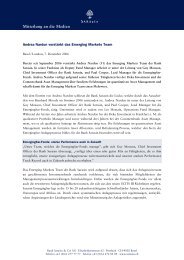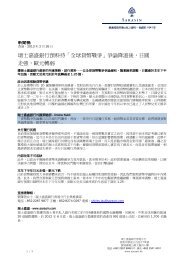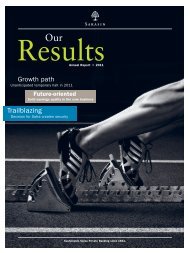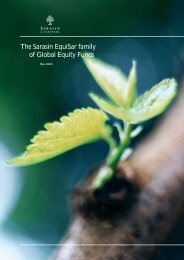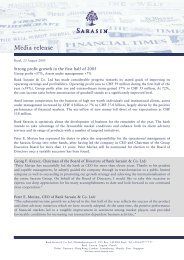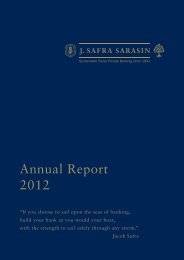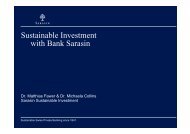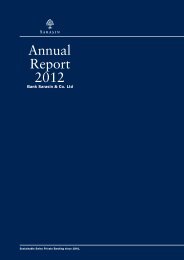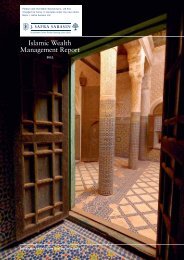Sustainability Report - Bank Sarasin-Alpen
Sustainability Report - Bank Sarasin-Alpen
Sustainability Report - Bank Sarasin-Alpen
You also want an ePaper? Increase the reach of your titles
YUMPU automatically turns print PDFs into web optimized ePapers that Google loves.
Solar Energy 2005<br />
WEEE directive<br />
The WEEE directive (waste of electric and electronic equipment) makes it compulsory<br />
for the industry to take back used electronics products.<br />
At present PV modules are explicitly excluded. But solar-powered calculators,<br />
clocks, etc. already fall under the directive. It is quite feasible that the legal situation<br />
could change once photovoltaics develop from a niche product into a massproduced<br />
technology.<br />
Initial initiatives are already under way for the recycling of solar modules.<br />
Deutsche Solar has set up a recycling plant and feeds the recovered solar-grade<br />
silicon back into its production process. Although the procedure for recycling wafers<br />
is rather laborious, it makes both environmental and financial sense because<br />
of the high manufacturing costs and the general shortage of raw material.<br />
Fragments of cells cannot be worked up directly into wafers, but first have to be<br />
melted and formed into silicon ingots. This leads to high energy consumption<br />
and substantial material loss. On the other hand, the recycled wafers can now<br />
also be produced in bigger dimensions.<br />
First Solar also takes back its CIS cells. However, this company uses the harmful<br />
substance cadmium, and its public reputation is therefore more vulnerable.<br />
A “green industry” such as photovoltaics would do well to proactively engage<br />
with these problems. Only if the industry takes the initiative itself in organising<br />
the return and disposal of its products will it be able to avoid the WEEE being<br />
extended to PV components as the quantities of materials it uses continue to<br />
grow in future.<br />
RoHS directive<br />
<strong>Sustainability</strong> also an issue<br />
in the IEA-PVPS<br />
PV components are not currently affected by the EU’s RoHS directive (restriction<br />
of the use of certain hazardous substances). As of 1 July 2006 lead, mercury,<br />
cadmium, hexavalent chromium and other substances can basically no longer be<br />
used in the manufacture of electrical and electronic equipment. The plan to ban<br />
lead in particular presents a challenge to the solar industry. Traditionally solder<br />
containing lead has almost always been used to join together the individual PV<br />
cells. But lead-free products are already available. Schott Solar uses solder<br />
made of 96.5% tin and 3.5% silver; the percentage of lead is tiny and complies<br />
with RoHS requirements. Crystalline modules produced by Mitsubishi Electric<br />
have been lead-free since 2003, according to company information. The RoHS<br />
directive presents a special challenge for manufacturers of thin-film modules<br />
based on cadmium telluride (CdTe). They will need to be granted a special exemption<br />
from the RoHS rules.<br />
At the 20th European Photovoltaics Conference in Barcelona the IEA-PVPS 9 organised<br />
a workshop on the topic of sustainability. Experts from the fields of environmental<br />
audit, recycling, product return systems and legislative bodies discussed<br />
the status quo. The results of the workshops reveal a common<br />
awareness of the issues and the need for further research into this area, as well<br />
as improved technical conditions.<br />
9<br />
www.iea-shc.org<br />
Dezember 2005 30


